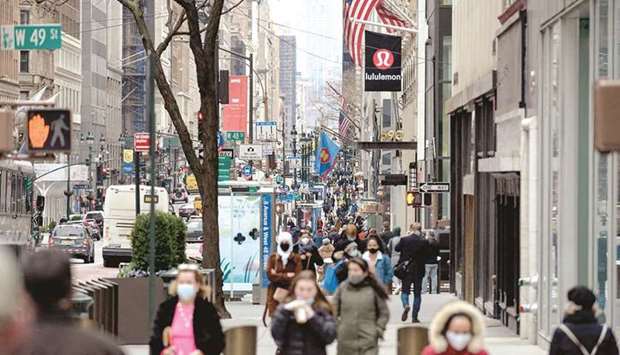The prevailing scenario for the US recovery on Wall Street and in Washington has until recently focused on a boom fuelled by consumers roaring back to life with a vengeance in a vaccine-induced reopening of the economy.
The reality emerging from the latest data is a bumpy rebound vulnerable to surprises. Whatever your take is on whether unemployment benefits in discouraging Americans from returning to work or how worrisome recent price hikes are – not very, says the Federal Reserve – the economy is flashing messy signals.
On Friday, stalling retail sales and rising inflation expectations capped a volatile week after major misses in the April consumer price and job reports.
At the heart of the grind is the labour market: Getting about 10mn people back to work after a third of the workforce changed or lost their jobs during the Covid-19 pandemic is going to take time, leaving some employers scrambling to fill positions amid brisk demand.
“This will be a chaotic recovery,” said Wendy Edelberg, former chief economist at the non-partisan Congressional Budget Office who now directs the Hamilton Project at the Brookings Institution.
Layered onto the data has been a cyberattack that caused gasoline shortages on the East Coast and prompted Republicans to invoke memories of the 1970s energy crisis.
Added to supply chain bottlenecks that have been a drag on automakers and other manufacturers, the hack has provided evidence of how vulnerable the US recovery remains to unanticipated shocks. And President Joe Biden’s ambitious plans to create millions of good-paying jobs as part of a $4tn package face massive barriers at both the federal and state level before they can materialise.
There is no doubt the US economy is rebounding. But the K-shaped bounce predicted by many is turning into a multi-headed monster.
In Ann Arbor, Michigan, you can see it in the business of dog-walker Christina Lirones.
Before the pandemic, she walked eight to ten dogs a day at $20 a walk and often spent weekends house-sitting for pet owners. Wednesday “was a stellar day for post-pandemic and I walked three dogs,” she said in an interview.
The worst is behind her. But demand is still slow. Plus Lirones, 60, has a daunting mountain of credit-card debt she built up during the pandemic by taking up zero-interest credit card offers rather than applying for unemployment benefits.
Lirones has a spreadsheet and a plan to pay off her cards before she has to start paying interest.
While stimulus checks she and her husband have received this year went mostly to doing exactly that, she still has a ways to go.
“Tens of thousands is 100% correct,” she texted on Friday. “Yikes. I try not to think about it.”
Economist Edelberg, like many of her peers, remains an optimist about what lies ahead. She expects amassed household savings and pent-up demand to be unleashed in the coming months as the pandemic is brought under control in the US.
The strongest sign yet of a return to everyday life came Thursday when the Centers for Disease Control and Prevention said vaccinated people can drop masks in most situations.
With the anticipated surge in demand for services such as travel, though, will come yet more mismatches with supply. They will lead to price spikes like the 10% surge in a month in used-car prices – the largest recorded since 1953 – reflected in Wednesday’s consumer price data.
“I fully expect airline prices to go through the roof,” Edelberg said.
Other data indicators point to the patchiness of the recovery.
The surge in job openings to a record high of 8.1mn in March underscored the fast-paced reopening of many businesses in the country but masked job reductions that have continued elsewhere.
In Burlington, Wisconsin, Swiss food giant Nestle SA on Wednesday notified authorities that it would be laying off almost three dozen workers at a factory that has for years made the chocolate “morsels” that many home bakers rely on. A spokeswoman for the company said Friday the cuts were related to the 2018 sale of its US confectionery business to Italy’s Ferrero-SpA/Alba.
In the past two weeks in Ohio, officials have received notices of layoffs from Sunbeam Products and engineering company OPW Engineered Systems.
“It is expected that this closure will be permanent,” an OPW official wrote in his letter to state officials announcing 103 job cuts due to take place over the summer.
Meanwhile, small businesses, which employed almost half the private workforce before the pandemic, have been rebounding more slowly than bigger counterparts.
By many accounts, business is on fire for some restaurants, hotels and hair salons, especially in the South, which reopened early. But an April survey by the National Federation of Independent Business also found a deterioration in the outlook for business conditions, partly because companies are struggling to find workers.
And data from Opportunity Insights, a research group based at Harvard University, show that total revenue at small firms is down about 29% compared with pre-pandemic January 2020 as of May 5.
Even the ideological battle over jobs and unemployment benefits is becoming more complicated. Several Republican-run states have announced that they will be pulling out of federal programs in the coming weeks.
Such a move, officials in those states said, will spur a new wave of people into the workforce. It will also cut the fiscal stimulus going into the economy in those states. According to the Labor Department, more than 12mn people nationally were receiving those federal benefits in April – and these people are consumers.
The dearth of workers in certain sectors and pockets of the country has led corporate giants such as Amazon.com Inc to announce increases in wages. At the same time, small businesses are trying to make sure the debate over a federal minimum wage doesn’t come back on the agenda, and many are offering one-time cash incentives to lure workers.

People walk on a busy 5th Avenue in midtown Manhattan. The prevailing scenario for the US recovery on Wall Street and in Washington has until recently focused on a boom fuelled by consumers roaring back to life with a vengeance in a vaccine-induced reopening of the economy.


